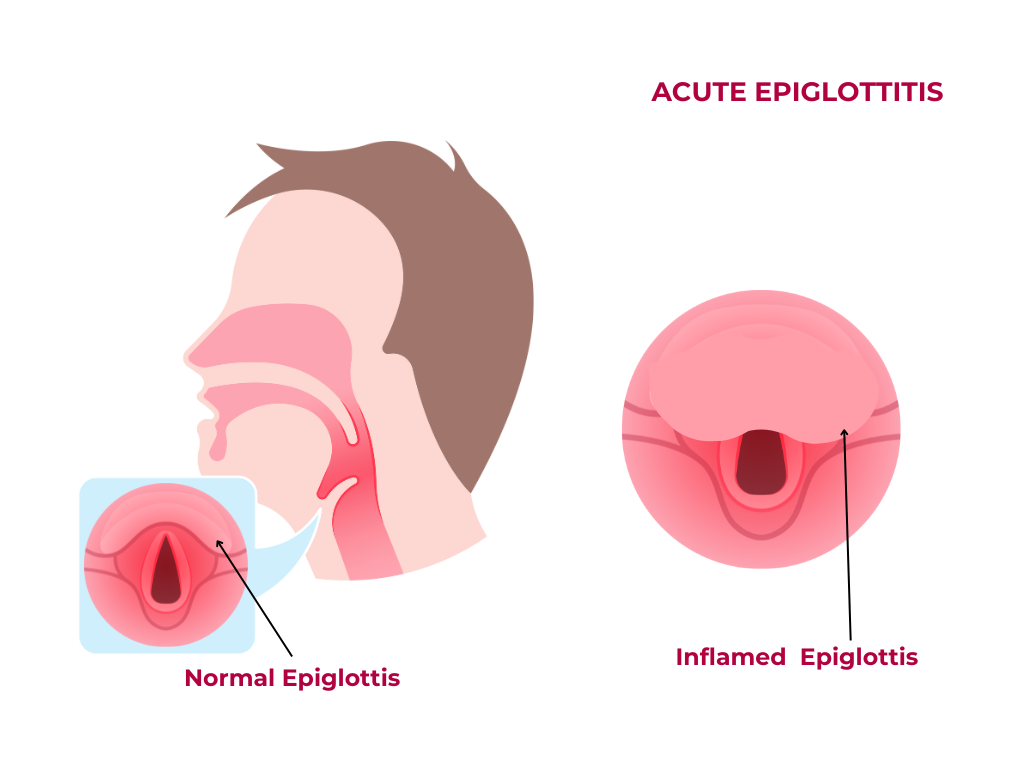Acute epiglottitis is a medical emergency characterized by inflammation of the epiglottis, which can lead to airway obstruction.
Epidemiology
-
1. Children:
Typically affects children between 2 - 7 years old, but can occur at any age.
-
2. Adults:
Increasingly recognized in adults, often with underlying health conditions.
Pathophysiology
-
1. Infection:
Usually caused by bacterial infection, with Haemophilus influenzae type b (Hib) being a common cause in children.
-
2. Inflammation:
Inflammation of the epiglottis can lead to airway obstruction .
Anatomy of Paediatric Epiglottis That Makes it Prone to Rapid Progression to Airway Obstruction
The anatomy of the pediatric epiglottis contributes to its propensity for rapid progression of edema in acute epiglottitis:
Anatomical Characteristics
-
1. Large and floppy epiglottis:
The pediatric epiglottis is relatively large and floppy compared to the adult epiglottis.
-
2. Loose areolar tissue:
The submucosal layer of the epiglottis contains loose areolar tissue, which can easily become edematous.
Consequences
-
1. Rapid swelling:
The loose areolar tissue can rapidly become edematous, leading to significant swelling of the epiglottis.
-
2. Airway obstruction:
The swollen epiglottis can obstruct the airway, leading to respiratory distress and potentially life-threatening complications.
Clinical Implications
-
1. Rapid progression:
Acute epiglottitis in children can progress rapidly, requiring prompt recognition and management.
-
2. Airway management:
Securing the airway is critical in managing acute epiglottitis in children.
The unique anatomy of the pediatric epiglottis makes it prone to rapid progression of edema in acute epiglottitis, emphasizing the need for prompt and effective management.
Aetiological Factors
Children
1. Haemophilus influenzae type b (Hib): Most common cause in children.
2. Viral infections: Can also be caused by viral infections.
Adults
1. Streptococcus pneumoniae: Common cause in adults.
2. Other bacteria: Other bacteria, such as Staphylococcus aureus, can also cause epiglottitis.
Symptoms and Signs
Symptoms
1. Sore throat: Severe sore throat.
2. Difficulty swallowing: Dysphagia.
3. High fever: Sudden onset of high fever.
4. Respiratory distress: Stridor, tachypnea, and use of accessory muscles.
Signs
1. Drooling: Due to difficulty swallowing.
2. Muffled voice: Voice may be muffled.
3. Stridor: Inspiratory stridor
Differential Diagnosis
-
1. Croup:
Viral infection causing inflammation of the larynx and trachea.
-
2. Retropharyngeal abscess:
Collection of pus in the tissues of the neck.
-
3. Other causes of upper airway obstruction:
Such as foreign body aspiration.
Comparison between Croup and Retropharyngeal Abscess
Croup
1. Viral etiology: Typically caused by viral infections.
2. Gradual onset: Symptoms develop gradually.
3. Barking cough: Characteristic barking cough.
Retropharyngeal Abscess
1. Collection of pus: Collection of pus in the tissues of the neck.
2. Neck stiffness: Limited neck mobility.
3. Imaging: Imaging studies can help diagnose.
Investigations
-
1. Lateral neck X-ray:
May show the "thumb sign" (enlarged epiglottis).
-
2. Blood tests:
May show elevated white blood cell count.
Complications
-
1. Airway obstruction:
Can lead to respiratory failure.
-
2. Respiratory arrest:
Can occur if airway obstruction is not managed promptly.
Management
Emergency Approach :
Initial Assessment
-
1. Rapid visual assessment:
Assess the child's airway, breathing, and circulation (ABCs).
-
2. Identify signs of respiratory distress:
Look for signs such as stridor, tachypnea, and use of accessory muscles.
Stabilization
-
1. Maintain a calm environment:
Keep the child calm and comfortable to minimize agitation.
-
2. Avoid agitating the child:
Minimize interventions that may agitate the child, such as forcing the child to lie down or attempting to visualize the airway.
-
3. Provide oxygen:
Administer oxygen if the child is hypoxemic, but avoid using a mask that may cause distress.
Securing the Airway
-
1. Call for anesthesiology and ENT:
Alert the anesthesiology and ear, nose, and throat (ENT) teams to prepare for potential airway management.
-
2. Prepare for intubation:
Prepare equipment for intubation, including a smaller endotracheal tube.
-
3. Intubation in a controlled setting:
Intubate the child in a controlled setting, such as the operating room, with ENT and anesthesiology teams present.
Monitoring
-
1. Close monitoring:
Closely monitor the child's vital signs, oxygen saturation, and airway status.
-
2. ENT consultation:
Consult with ENT specialists for further management and potential surgical intervention.
Key Considerations
-
1. Avoid examining the throat:
Avoid examining the throat or using a tongue depressor, as this may cause further distress.
-
2. Maintain a high index of suspicion:
Maintain a high index of suspicion for epiglottitis in children presenting with respiratory distress and signs of upper airway obstruction.
Definitive Management
1. Secure the airway: Intubation or tracheostomy may be necessary.
2. Antibiotics: Administer broad-spectrum antibiotics.
3. Steroids: May be used to reduce inflammation.
Role of Healthcare Professionals
Paediatricians
1. Early recognition: Recognize symptoms and signs.
2. Initial management: Provide initial care.
Anaesthesiologists
1. Airway management: Manage the airway.
2. Intubation: Perform intubation.
ENT Surgeons
1. Airway management: Assist with airway management.
2. Tracheostomy: Perform tracheostomy if necessary.
In conclusion, acute epiglottitis is a medical emergency requiring prompt recognition and management. A multidisciplinary approach involving paediatricians, anaesthesiologists, and ENT surgeons is crucial to ensure optimal outcomes
Share Post On:
Recent Posts
-
Peritonsillar Abscess
-
Ethics of Doctor-Patient Relationship
-
Doctor-Patient Relationship Case Scenarios
-
Asymmetrical Tonsils and Approach to Evaluation and Management
-
Nasal Polyposis
-
Rigid Oesophagoscopy and Complication
-
Anatomy of Oesophagus
-
Stridor, Snoring, Stertor And Wheezing: How They Compare
-
Temporomandibular Joint (TMJ)
-
Otoacoustic Emissions
-
Tympanometry
-
Functional Endoscopic Sinus Surgery (FESS)
-
Tracheostomy
-
Clinical Voice Test (CVT) for Hearing Loss
-
Acute Epiglottitis And Approach To Management
-
Synoptic Overview Of Nasopharyngeal Carcinoma
-
Prioritizing Support For People With Disabilities Over Unhealthy Competitions That Marginalise The Downtrodden
-
Otitic Barotrauma
-
Titbits of Informed Consent Process for a Medical or Surgical Procedure
-
Comprehensive Overview of Mpox (Monkeypox)
-
Overview Of Corrosive Ingestion - Acid & Alkalis, and Management Approach
-
Ethical Conundrum
-
Comprehensive Overview of Laryngeal Papillomatosis and HPV Virus
-
All You Need To *Know About Gardasil*
-
Preauricular Sinus
-
Laryngomalacia - comprehensive overview
-
Flexible Laryngoscopy features of Laryngomalacia
-
Case Report of a Rare Cause of Upper Airway Obstruction In Adults
-
Usefulness of The Neck Soft Tissues X-Ray
-
Paranasal Sinuses Radiology
-
Swallow Function Test
-
Radiotherapy and Chemotherapy In Head And Neck Cancers
-
Myringoplasty
-
Overview of Chronic Suppurative Otitis Media (CSOM)
-
Overview Of Otitis Externa
-
What You Need To Know About Red Meat And Cancer
-
All You Need To Know About Cawthorne-Cooksey Vestibular Rehabilitation Exercises
-
Hoarseness Of Voice - Comprehensive Overview
-
Epleys Manoeuvre
-
Allergic rhinitis (AR)
Categories
Get in Touch
Read doctor-produced health and medical information written for you to make informed decisions about your health concerns.


